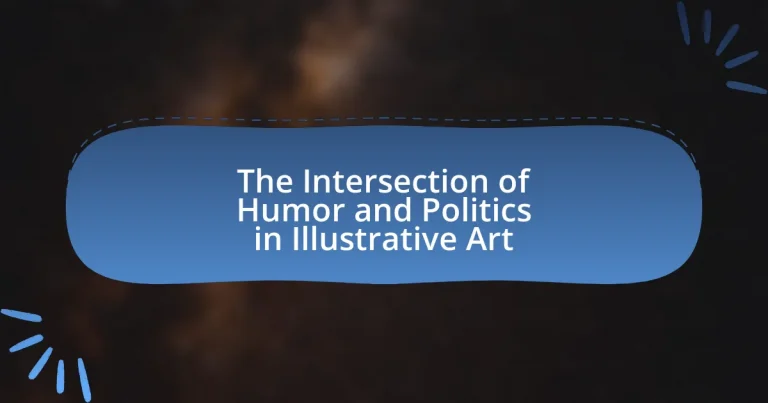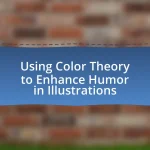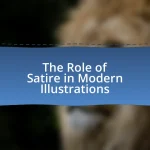The article explores the intersection of humor and politics in illustrative art, highlighting how satire and commentary converge to critique societal issues and political figures. It examines the techniques used in political illustrations, such as satire, exaggeration, and visual metaphors, and discusses the influence of audience perception on the effectiveness of political messages. The article also addresses the historical impact of illustrative art on politics, the role of technology and social media in modern political humor, and the ethical considerations artists face when using humor in their work. Additionally, it outlines best practices for creating effective humorous political illustrations and the implications of humor in public engagement and voter behavior.
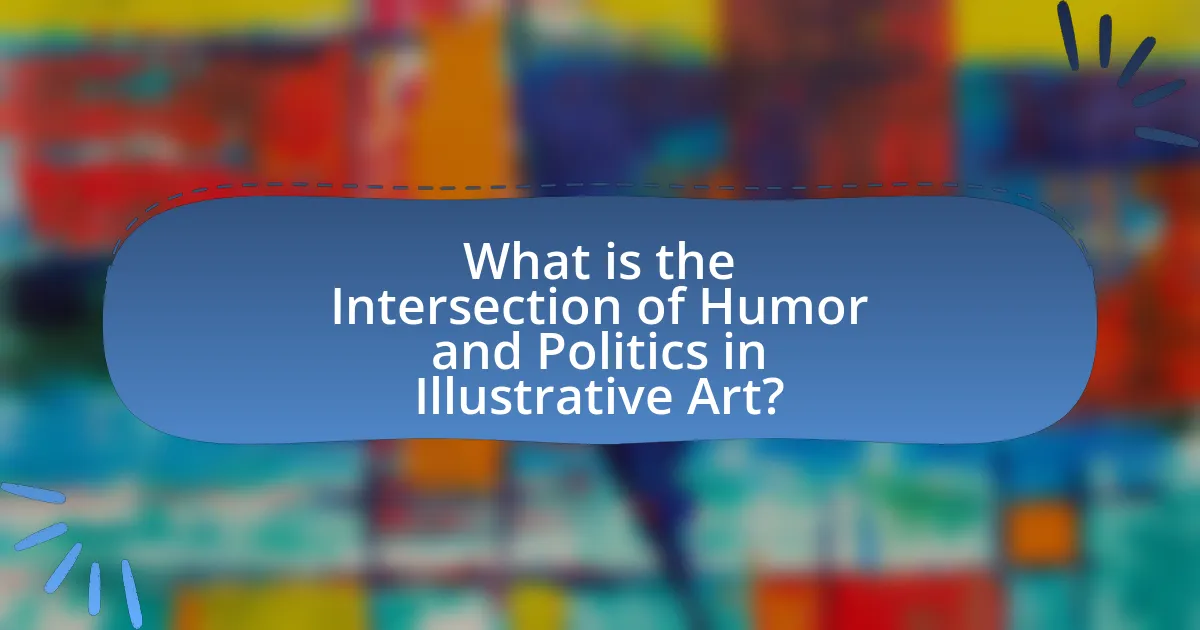
What is the Intersection of Humor and Politics in Illustrative Art?
The intersection of humor and politics in illustrative art is a dynamic space where satire and commentary converge to critique societal issues and political figures. Illustrative art often employs humor to simplify complex political narratives, making them accessible and engaging for a broader audience. For instance, political cartoons have historically used exaggeration and caricature to highlight the absurdities of political situations, as seen in the works of artists like Thomas Nast in the 19th century, who used humor to expose corruption in politics. This blend of humor and political commentary not only entertains but also provokes thought and encourages public discourse, demonstrating the power of art as a tool for social change.
How does humor influence political commentary in illustrative art?
Humor significantly influences political commentary in illustrative art by providing a means to critique and engage audiences in complex political issues. Illustrative art often employs satire and caricature, which can simplify intricate political narratives, making them more accessible and relatable to the public. For instance, artists like Honoré Daumier and more contemporary figures such as Steve Bell use humor to highlight societal flaws and political absurdities, effectively prompting viewers to reflect on serious topics while being entertained. This dual engagement fosters critical thinking and can mobilize public opinion, as seen in various political cartoons that have historically sparked discussions and movements.
What are the key elements of humor used in political illustrations?
The key elements of humor used in political illustrations include satire, exaggeration, irony, and visual puns. Satire allows artists to critique political figures and policies by highlighting absurdities, often using wit to provoke thought. Exaggeration amplifies certain traits or situations, making them more recognizable and humorous, as seen in caricatures of politicians. Irony creates a contrast between expectations and reality, often revealing hypocrisy or contradictions in political discourse. Visual puns combine imagery and wordplay, engaging viewers through clever associations. These elements collectively enhance the effectiveness of political illustrations in conveying messages and stimulating public discourse.
How does the audience’s perception of humor affect political messages?
The audience’s perception of humor significantly influences the effectiveness of political messages. When humor is perceived positively, it can enhance engagement, making political content more relatable and memorable. For instance, studies show that humorous political satire can increase audience receptiveness to political ideas, as seen in programs like “The Daily Show,” which often leads to higher political awareness among viewers. Conversely, if humor is perceived as offensive or inappropriate, it can alienate the audience, diminishing the impact of the political message. Research indicates that humor that aligns with the audience’s values and beliefs fosters a sense of connection, while humor that contradicts these can provoke backlash, ultimately affecting the audience’s acceptance of the political message.
Why is illustrative art a powerful medium for political expression?
Illustrative art is a powerful medium for political expression because it effectively communicates complex ideas and emotions in a visually engaging manner. This form of art can simplify intricate political issues, making them accessible to a broader audience. For instance, political cartoons have historically influenced public opinion by using satire to critique government actions, as seen in the works of artists like Thomas Nast during the 19th century, who played a crucial role in shaping perceptions of political corruption. Additionally, illustrative art can evoke strong emotional responses, prompting viewers to reflect on societal issues, as demonstrated by the impactful imagery used in protest posters during movements like the Women’s March. This ability to blend humor with serious commentary allows illustrative art to resonate deeply, fostering dialogue and encouraging activism.
What historical examples demonstrate the impact of illustrative art on politics?
Illustrative art has significantly impacted politics throughout history, with notable examples including the political cartoons of Thomas Nast during the 19th century. Nast’s illustrations played a crucial role in shaping public opinion against political corruption, particularly targeting Tammany Hall and its leader, Boss Tweed, which ultimately contributed to Tweed’s downfall and the reform of New York City’s political system. Another example is the use of propaganda posters during World War I and II, such as the “Uncle Sam Wants You” poster, which effectively mobilized public support for military enlistment and war efforts. These instances demonstrate how illustrative art can influence political narratives and public sentiment, leading to tangible political outcomes.
How do different cultures utilize illustrative art for political commentary?
Different cultures utilize illustrative art for political commentary by employing satire, caricature, and visual metaphors to critique political figures and social issues. For instance, in the United States, political cartoons often exaggerate the features of politicians to highlight their flaws, as seen in the works of Thomas Nast during the 19th century, which played a significant role in shaping public opinion against corruption. In contrast, in countries like Iran, artists use symbolic imagery to convey dissent against governmental policies while navigating censorship, as demonstrated by the works of artists like Shirin Neshat, who address themes of identity and oppression. Furthermore, in Mexico, the tradition of “calaveras” or skull illustrations during Día de los Muertos serves as a means to comment on social inequalities and political corruption, reflecting the culture’s unique approach to death and politics. These examples illustrate how illustrative art serves as a powerful medium for political expression across various cultural contexts.
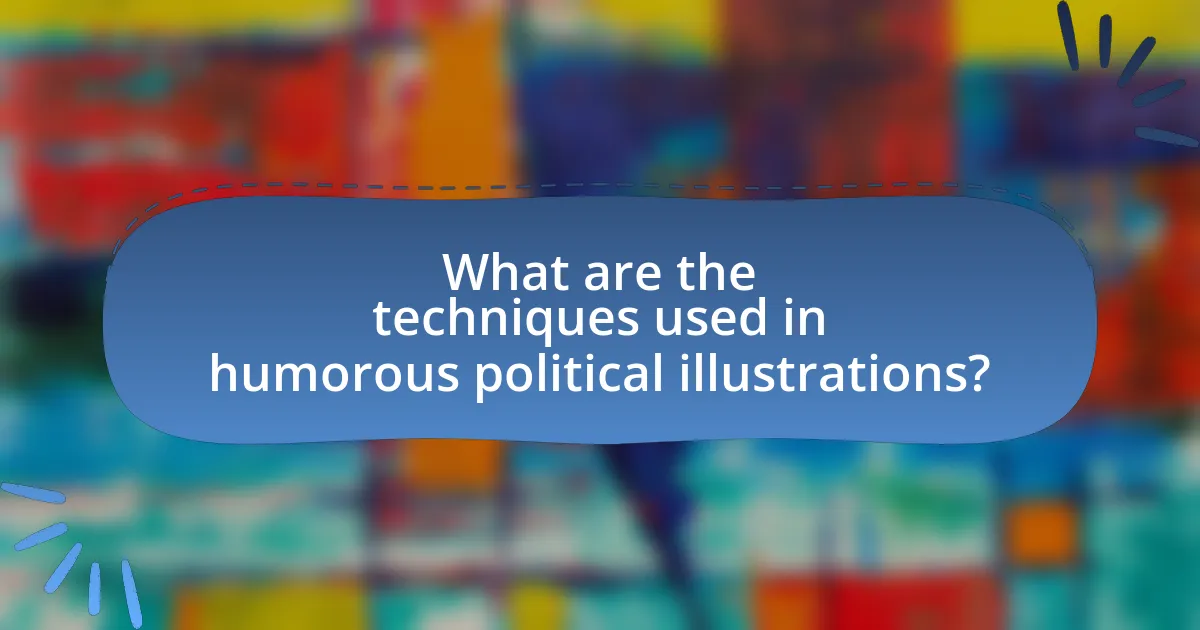
What are the techniques used in humorous political illustrations?
Humorous political illustrations employ techniques such as satire, caricature, visual puns, and exaggeration. Satire critiques political figures or situations through humor, often highlighting absurdities in policies or behaviors. Caricature distorts physical features or traits of politicians to emphasize their characteristics, making them instantly recognizable and often ridiculed. Visual puns create humor through clever imagery that plays on words or concepts related to politics, engaging the audience in a playful manner. Exaggeration amplifies certain aspects of political scenarios or figures to evoke laughter and provoke thought, effectively communicating a message while entertaining the viewer. These techniques are widely used in editorial cartoons and satirical art, contributing to public discourse by making complex political issues more accessible and engaging.
How do artists blend satire and humor in their work?
Artists blend satire and humor in their work by using exaggeration, irony, and wit to critique societal norms and political issues. This technique allows them to engage audiences while provoking thought about serious topics. For instance, artists like George Cruikshank and more contemporary figures such as Banksy employ visual metaphors and absurdity to highlight contradictions in politics and culture. The effectiveness of this approach is evident in how it encourages viewers to reflect on the underlying messages, often leading to a deeper understanding of the issues at hand.
What role does exaggeration play in humorous political illustrations?
Exaggeration plays a crucial role in humorous political illustrations by amplifying characteristics of political figures or situations to evoke laughter and critique. This technique highlights absurdities in politics, making complex issues more accessible and engaging for the audience. For instance, artists often exaggerate facial features or behaviors of politicians to underscore their flaws or controversial actions, effectively using humor as a tool for social commentary. Historical examples include caricatures from the 19th century, where artists like Thomas Nast used exaggerated depictions of political figures to influence public opinion and provoke thought on societal issues.
How do visual metaphors enhance the humor in political art?
Visual metaphors enhance the humor in political art by creating relatable and exaggerated representations of complex political issues. These metaphors simplify intricate ideas, making them accessible and amusing to a broader audience. For instance, a common visual metaphor is depicting politicians as animals, which can evoke humor through the absurdity of the comparison while simultaneously critiquing their behaviors or policies. This technique allows artists to convey serious messages in a light-hearted manner, engaging viewers emotionally and intellectually. Research indicates that humor in political art can increase public interest and discussion around political topics, as seen in works by artists like David Levine, who used caricature to highlight political absurdities effectively.
What challenges do artists face when using humor in political illustrations?
Artists face significant challenges when using humor in political illustrations, primarily due to the risk of misinterpretation and backlash. Political humor can easily offend or alienate audiences, as humor is subjective and can be perceived differently based on cultural, social, or political contexts. For instance, a satirical depiction of a political figure may be seen as funny by some but as disrespectful or harmful by others, leading to public outrage or censorship. Additionally, artists must navigate the fine line between critique and mockery, as overly harsh humor can undermine the intended message and diminish the impact of their work. The complexity of political issues further complicates this, as artists must distill multifaceted topics into concise, humorous illustrations without oversimplifying or misrepresenting the subject matter.
How can humor backfire in political commentary?
Humor can backfire in political commentary by alienating audiences or trivializing serious issues. When humor is perceived as offensive or inappropriate, it can lead to backlash against the commentator, diminishing their credibility and support. For instance, a satirical piece that misrepresents a political figure may provoke outrage, causing the intended message to be lost. Additionally, humor that oversimplifies complex political situations can result in misunderstandings, as audiences may take the joke literally rather than grasping the underlying critique. This phenomenon is evident in various political cartoons that, while aiming to provoke thought, sometimes reinforce stereotypes or polarize opinions instead.
What are the ethical considerations for artists in this genre?
Artists in the genre of illustrative art that intersects humor and politics must navigate several ethical considerations, including the potential for misrepresentation, the impact of satire on public perception, and the responsibility to avoid perpetuating harmful stereotypes. Misrepresentation can occur when humor distorts political realities, leading audiences to misunderstand complex issues. For instance, satirical works may oversimplify or exaggerate political figures’ actions, which can skew public opinion. Additionally, artists have a responsibility to consider how their work may reinforce or challenge societal norms and stereotypes, as humor can either critique or inadvertently support harmful narratives. The ethical implications of these choices are significant, as they can influence societal discourse and contribute to the shaping of political landscapes.
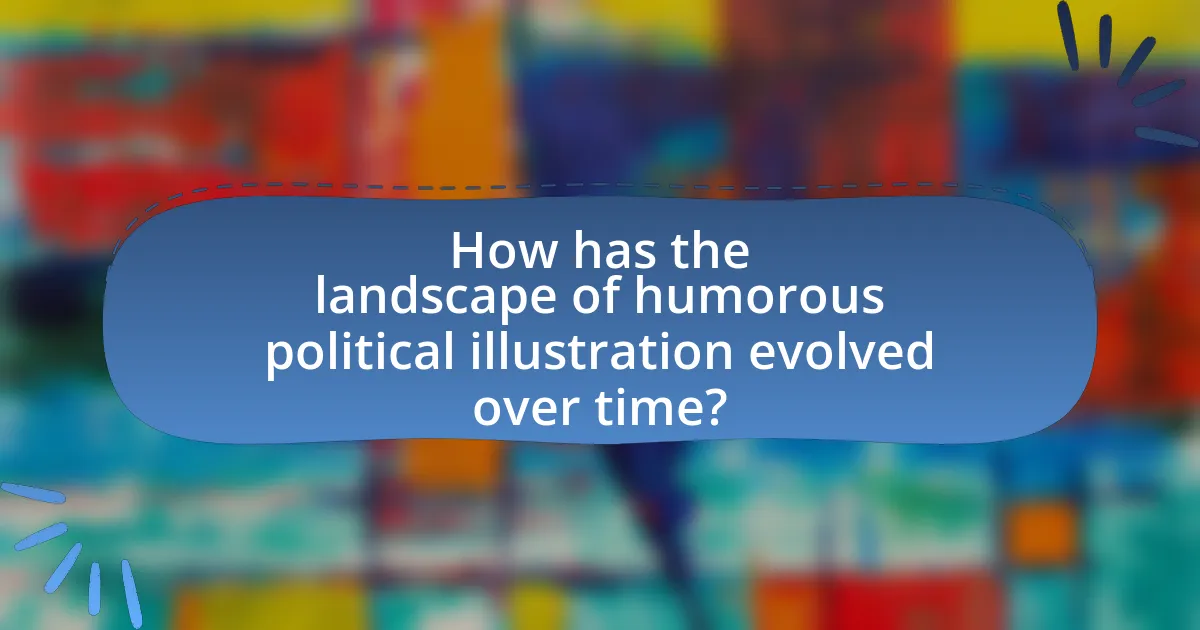
How has the landscape of humorous political illustration evolved over time?
The landscape of humorous political illustration has evolved significantly from the satirical engravings of the 18th century to contemporary digital cartoons. Initially, political illustrations served as tools for social commentary and critique, exemplified by artists like James Gillray, whose works targeted political figures and societal issues in Britain. As technology advanced, the medium transitioned from print to digital platforms, allowing for rapid dissemination and broader audience engagement. The rise of social media has further transformed this landscape, enabling artists to respond instantly to political events and trends, as seen in the works of contemporary illustrators like Ben Sargent and Ann Telnaes. This evolution reflects changes in political discourse and public engagement, highlighting the enduring power of humor in shaping political narratives.
What role does technology play in modern political illustrations?
Technology plays a crucial role in modern political illustrations by enabling artists to create, distribute, and engage with their work more effectively. Digital tools such as graphic design software and social media platforms allow illustrators to produce high-quality images quickly and share them widely, reaching diverse audiences instantly. For instance, the use of platforms like Instagram and Twitter has transformed how political cartoons are disseminated, allowing for real-time commentary on current events. According to a study by the Pew Research Center, 72% of adults in the U.S. use social media, highlighting its significance in shaping public discourse through visual art. This integration of technology not only enhances the creative process but also amplifies the impact of political illustrations in contemporary society.
How has social media changed the way political humor is shared and consumed?
Social media has transformed the sharing and consumption of political humor by enabling rapid dissemination and broad accessibility. Platforms like Twitter and Facebook allow users to create, share, and engage with humorous political content instantly, reaching diverse audiences across geographical boundaries. According to a 2020 study by the Pew Research Center, 55% of Americans reported that social media is a significant source of political news, indicating its role in shaping public discourse. This shift has led to the rise of memes and viral content, which often satirize political figures and events, making humor a tool for political commentary and mobilization.
What are the trends in humorous political illustration today?
Current trends in humorous political illustration include the use of digital platforms for rapid dissemination, a focus on social media engagement, and the incorporation of diverse cultural perspectives. Illustrators increasingly leverage social media to reach wider audiences, with platforms like Instagram and Twitter serving as primary venues for sharing their work. This shift has led to a more immediate and interactive relationship between artists and viewers, allowing for real-time commentary on political events. Additionally, there is a growing emphasis on inclusivity, with artists from various backgrounds contributing unique viewpoints that reflect a broader spectrum of societal issues. This trend is supported by the rise of global movements that demand representation and accountability in political discourse, making humorous political illustrations a vital tool for critique and engagement.
What are the implications of humor in political discourse?
Humor in political discourse serves as a tool for engagement, critique, and social commentary. It can simplify complex issues, making them more accessible to the public, while also providing a means to challenge authority and question societal norms. For instance, satirical programs like “Saturday Night Live” have historically influenced public perception of political figures, as evidenced by studies showing that viewers of satirical content are more informed about political issues compared to non-viewers. Additionally, humor can foster a sense of community among those who share similar political views, while also alienating opposing perspectives. This duality highlights the power of humor to both unite and divide, shaping the landscape of political dialogue.
How does humor contribute to public engagement in politics?
Humor significantly enhances public engagement in politics by making complex issues more relatable and accessible. It serves as a tool to simplify political discourse, allowing individuals to connect emotionally with political content. For instance, satirical programs like “The Daily Show” have been shown to increase political knowledge and encourage civic participation among viewers, particularly younger audiences. Research by the Pew Research Center indicates that humor can lower barriers to political discussion, fostering a more open dialogue about important issues. This engagement is crucial for a healthy democracy, as it encourages informed citizenry and active participation in the political process.
What impact does humorous political art have on voter behavior?
Humorous political art significantly influences voter behavior by increasing engagement and fostering critical thinking. This type of art often simplifies complex political issues, making them more accessible and relatable to a broader audience. Research indicates that humor can enhance message retention; for instance, a study published in the journal “Political Psychology” found that humorous political cartoons increased viewers’ recall of political messages by 20%. Additionally, humorous art can create a sense of community among like-minded individuals, encouraging discussions and mobilizing voters. By appealing to emotions and breaking down barriers, humorous political art can effectively sway public opinion and motivate electoral participation.
What are best practices for creating effective humorous political illustrations?
Effective humorous political illustrations should combine clarity, relevance, and wit to resonate with the audience. Clarity ensures that the message is easily understood, while relevance connects the illustration to current political events or issues, making it timely and impactful. Wit enhances the humor, allowing the illustration to engage viewers and provoke thought.
For instance, successful political cartoonists like Gary Larson and Pat Oliphant often use exaggerated caricatures and visual metaphors to convey complex political ideas succinctly. Research indicates that humor can increase the retention of political messages, as seen in studies published in the Journal of Communication, which highlight that humor aids in processing and remembering political information. Thus, incorporating these elements—clarity, relevance, and wit—can significantly enhance the effectiveness of humorous political illustrations.
How can artists balance humor and seriousness in their work?
Artists can balance humor and seriousness in their work by using humor as a tool to engage audiences while addressing serious themes. This approach allows artists to create a dialogue around complex political issues without alienating viewers. For instance, satirical art often employs humor to critique societal norms, making difficult subjects more accessible. Historical examples include the works of artists like George Grosz and Honoré Daumier, who used caricature and satire to comment on political corruption and social injustice, effectively blending humor with serious commentary. This method not only captivates the audience but also encourages reflection on the underlying serious issues.
What tips can artists follow to resonate with their audience through humor?
Artists can resonate with their audience through humor by incorporating relatable experiences and cultural references into their work. This approach allows audiences to connect with the humor on a personal level, making the art more impactful. For instance, using everyday situations or common societal issues can create a shared understanding that enhances the comedic effect. Research indicates that humor that reflects the audience’s cultural context is more likely to be appreciated, as seen in studies on humor perception across different demographics. By tailoring humor to the audience’s background and experiences, artists can effectively engage and resonate with them.
